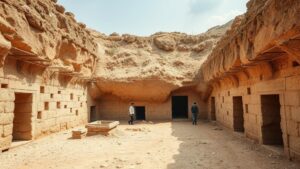Searching for the secrets hidden in the Copper Scroll, part of the Dead Sea Scrolls.
The Mystery of the Copper Scroll
The Copper Scroll, discovered in 1952 in Cave 3 at Qumran, is one of the most intriguing artifacts among the Dead Sea Scrolls. Unlike other scrolls that are made of parchment, this document is unique–it is fashioned from copper and inscribed with a series of locations, leading many to speculate about its purpose. The text describes a treasure trove consisting of gold, silver, and other valuable items, sparking a quest for hidden riches that has attracted archaeologists, historians, and treasure hunters alike.
Historical Context
The Dead Sea Scrolls were discovered between 1947 and 1956 in eleven caves near the Dead Sea, primarily in the region that is now known as the West Bank. Copper Scroll itself is dated to approximately 100 CE, and it is believed to have been written during a tumultuous period in Jewish history, marked by Roman occupation and the revolt of the Jewish people against their oppressors.
Qumran, where the scrolls were found, was inhabited by a sect known as the Essenes, who were known for their ascetic lifestyle and commitment to a communal and religious way of life. The Copper Scroll stands apart from other religious texts found among the Dead Sea Scrolls due to its emphasis on material wealth rather than spiritual teachings.
The Content of the Copper Scroll
The scroll is divided into 64 entries, each detailing locations believed to contain hidden treasures, which may total over 100 million denarii, an astronomical sum in the first century. Here are some key examples:
- Entry 6 refers to treasure hidden under the mountain of Jerusalem. This vagueness has led to various interpretations regarding its actual location.
- Entry 9 describes treasures placed in the 12th cave, fueling speculation about undiscovered caves in the vicinity of Qumran.
The significant use of detailed geographical descriptions provides clues that suggest a well-planned hiding of these treasures, which has spurred numerous excavations and quests for these lost riches over the decades.
Deciphering the Scroll
Decoding the Copper Scroll has proven to be a formidable challenge due to its unique script and the use of abbreviations. Scholars have employed various techniques to decipher its text, ranging from conventional linguistic approaches to advanced imaging technologies that reveal hidden details. For example, initial readings interpret the scrolls language as a form of Hebrew infused with elements of idiomatic phrases common in the time of its writing.
Some historians believe that the Copper Scroll could be a reflection of the last vestiges of the Temple treasures prior to its destruction in 70 CE. This connection adds historical weight to the quest for understanding its contents and context.
The Quest for the Treasure
The allure of the treasure described in the Copper Scroll has incited numerous treasure hunts, with varying degrees of success. One notable search occurred in the late 1950s and early 1960s when a team led by archaeologist John Allegro sought to uncover the treasures but ultimately found little tangible success.
In more recent times, advancements in technology like ground-penetrating radar and magnetic surveying have revitalized interest in locating the treasures mentioned in the Copper Scroll. Researchers have meticulously mapped out the Qumran area, testing the viability of the descriptions provided in the scroll. But, as noted by archaeologist Jodi Magness, “the evidence for the existence of the treasures described in the Copper Scroll is circumstantial at best.”
Impact on Archaeology and Religion
The Copper Scroll has significantly impacted the fields of archaeology and religious studies. It raises fundamental questions about the context of early Judaism, the role of material wealth in religious life, and the nature of the treasures linked to Temple practices. It challenges the assumption that followers of the Essenes would renounce wealth entirely, showcasing the complexities of their beliefs.
Also, discoveries stemming from the scroll have expanded the narrative surrounding the Second Temple period and its socio-political complexities, contributing to our understanding of Jewish history before the rise of Rabbinic Judaism.
Conclusion: The Ongoing Mystery
The search for the secrets hidden in the Copper Scroll remains unresolved. As scholars continue to study the text and pursue archaeological investigations, it serves as a vivid reminder of the intertwining of history, culture, and mystery. The debacle of treasure hunting not only captivates those with a penchant for adventure but also enriches academic discourse surrounding one of the most significant periods in Jewish history.
Whether or not the treasures described in the Copper Scroll will ever be unearthed remains uncertain. But, the quest continues to inspire fascination, leading us to ponder the secrets that history may still hold just below the surface.



